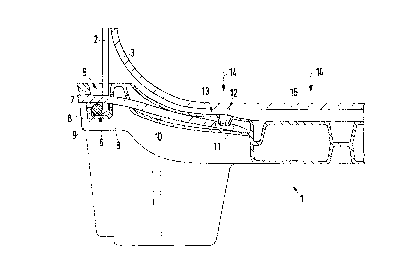Some of the information on this Web page has been provided by external sources. The Government of Canada is not responsible for the accuracy, reliability or currency of the information supplied by external sources. Users wishing to rely upon this information should consult directly with the source of the information. Content provided by external sources is not subject to official languages, privacy and accessibility requirements.
Any discrepancies in the text and image of the Claims and Abstract are due to differing posting times. Text of the Claims and Abstract are posted:
| (12) Patent: | (11) CA 2102386 |
|---|---|
| (54) English Title: | PALLET CONTAINER COMPRISING A PALLET, AN OUTER HOUSING AND A PLASTICS INNER TANK |
| (54) French Title: | CONTENANT CONSTITUE D'UNE PALETTE, D'UNE ENVELOPPE EXTERIEURE ET D'UN TUBE INTERNE EN MATIERE PLASTIQUE |
| Status: | Expired and beyond the Period of Reversal |
| (51) International Patent Classification (IPC): |
|
|---|---|
| (72) Inventors : |
|
| (73) Owners : |
|
| (71) Applicants : |
|
| (74) Agent: | BORDEN LADNER GERVAIS LLP |
| (74) Associate agent: | |
| (45) Issued: | 1999-04-06 |
| (22) Filed Date: | 1993-11-03 |
| (41) Open to Public Inspection: | 1994-05-05 |
| Examination requested: | 1995-08-08 |
| Availability of licence: | N/A |
| Dedicated to the Public: | N/A |
| (25) Language of filing: | English |
| Patent Cooperation Treaty (PCT): | No |
|---|
| (30) Application Priority Data: | ||||||
|---|---|---|---|---|---|---|
|
A pallet container comprising a pallet, an outer housing and a plastics inner tank. The
outer housing is releasably connected near its bottom edge to the pallet. The inner tank is
introduced into the outer housing supported on the pallet. The pallet is formed with a
peripheral groove for receiving the outer housing, which engages in the groove by way of its
bottom edge. The bottom edge of the outer housing is secured in the groove by retaining
tongues which extend through edge-closed recesses in the groove, engage over components
of the bottom edge of the outer housing and are releasably secured in the pallet.
Cette invention concerne une palette-caisse porte-réservoir composée d'une palette d'une caisse grillagée et d'un réservoir en plastique. La caisse est fixée à la palette de façon amovible par son extrémité inférieure. Le réservoir est placé dans la caisse montée sur la palette. Cette dernière comporte dans sa face supérieure une gorge périphérique destinée à recevoir la base des parois de caisse. La base de la caisse est maintenue dans la gorge susmentionnée au moyen de languettes de retenue insérées dans des logements ménagés dans la palette perpendiculairement à ladite gorge, lesdites languettes passant au-dessus de la barre inférieure formant la base de la caisse grillagée et étant verrouillées de façon amovible dans la palette.
Note: Claims are shown in the official language in which they were submitted.
Note: Descriptions are shown in the official language in which they were submitted.

2024-08-01:As part of the Next Generation Patents (NGP) transition, the Canadian Patents Database (CPD) now contains a more detailed Event History, which replicates the Event Log of our new back-office solution.
Please note that "Inactive:" events refers to events no longer in use in our new back-office solution.
For a clearer understanding of the status of the application/patent presented on this page, the site Disclaimer , as well as the definitions for Patent , Event History , Maintenance Fee and Payment History should be consulted.
| Description | Date |
|---|---|
| Inactive: IPC from MCD | 2006-03-11 |
| Inactive: IPC from MCD | 2006-03-11 |
| Time Limit for Reversal Expired | 2000-11-03 |
| Letter Sent | 1999-11-03 |
| Grant by Issuance | 1999-04-06 |
| Inactive: Final fee received | 1998-11-05 |
| Pre-grant | 1998-11-05 |
| Notice of Allowance is Issued | 1998-06-12 |
| Notice of Allowance is Issued | 1998-06-12 |
| Letter Sent | 1998-06-12 |
| Inactive: Status info is complete as of Log entry date | 1998-06-10 |
| Inactive: Application prosecuted on TS as of Log entry date | 1998-06-10 |
| Inactive: IPC removed | 1998-04-24 |
| Inactive: First IPC assigned | 1998-04-24 |
| Inactive: IPC assigned | 1998-04-24 |
| Inactive: Approved for allowance (AFA) | 1998-04-23 |
| Request for Examination Requirements Determined Compliant | 1995-08-08 |
| All Requirements for Examination Determined Compliant | 1995-08-08 |
| Application Published (Open to Public Inspection) | 1994-05-05 |
There is no abandonment history.
The last payment was received on 1998-10-23
Note : If the full payment has not been received on or before the date indicated, a further fee may be required which may be one of the following
Please refer to the CIPO Patent Fees web page to see all current fee amounts.
| Fee Type | Anniversary Year | Due Date | Paid Date |
|---|---|---|---|
| MF (application, 4th anniv.) - standard | 04 | 1997-11-03 | 1997-09-23 |
| MF (application, 5th anniv.) - standard | 05 | 1998-11-03 | 1998-10-23 |
| Final fee - standard | 1998-11-05 |
Note: Records showing the ownership history in alphabetical order.
| Current Owners on Record |
|---|
| SOTRALENTZ S.A. |
| Past Owners on Record |
|---|
| CLAUDE DECROIX |
| LYLE H. SHUERT |